Liverpool - Maritime Mercantile City was removed from the UNESCO World Heritage List in 2021.
Liverpool - Maritime Mercantile City: The city and port of Liverpool are an exceptional testimony to the development of maritime mercantile culture in the 18th and 19th centuries. The port of Liverpool played a considerable role in the growth of the British Empire. Liverpool played also an important role in the development of dock construction, port management and international trading systems in the 18th and 19th centuries. Liverpool - Maritime Mercantile City also played an leading role in Trans - Atlantic Slave Trade. It became the major port for the mass movement of people, millions of people emigrated from all over Europe to the United States and Canada. The White Star Line was one of the first shipping companies to have passenger ships. The White Star Line headquarters was located in Liverpool, the shipping company owned the Titanic. The balcony from which the cruel fate of the Titanic was announced still exists. Liverpool - Maritime Mercantile City consist of six areas: Albert Dock, Stanley Dock, Pier Head, Duke's Street, the 'Commercial Quarter' / Castle street and the 'Cultural Quarter' / William Brown street, including St. George's Plateau. Albert Dock is home to Tate Liverpool, part of the Tate Galleries in London. The Royal Liver Building was the firts skyscraper in Great Britain, the building is decorated with liver birds. The liver bird is the symbol of the city of Liverpool. Liverpool - Maritime Mercantile City was declared a UNESCO World Heritage in 2004. Liverpool - Maritime Mercantile City was included on the UNESCO Red List in 2012.
www.werelderfgoedfotos.nl © Copyright World Heritage Photos
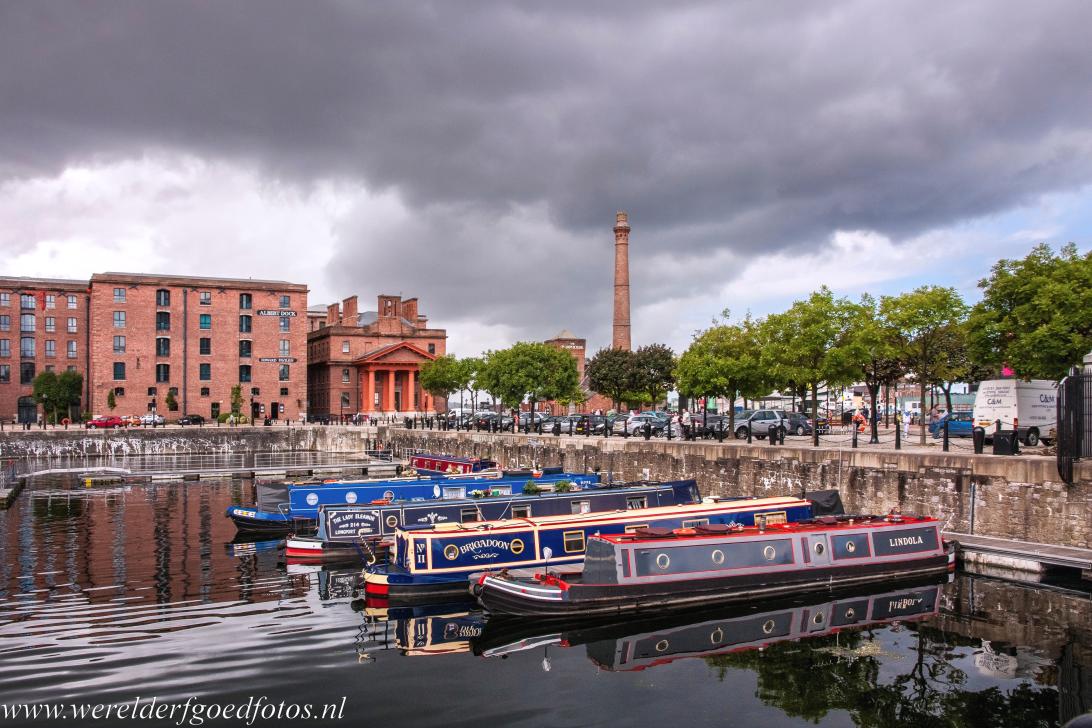
Liverpool - Maritime Mercantile City: In the very heart of the Royal Albert Dock rises the tall chimney of the Pump House. The Port of Liverpool played an important role in the growth of the British Empire. The maritime city and the Port of Liverpool are an exceptional testimony to the development of maritime mercantile culture in the 18th and 19th centuries.

Liverpool - Maritime Mercantile City: In the very heart of the Royal Albert Dock rises the tall chimney of the Pump House. The Port of Liverpool played an important role in the growth of the British Empire. The maritime city and the Port of Liverpool are an exceptional testimony to the development of maritime mercantile culture in the 18th and 19th centuries.

Liverpool - Maritime Mercantile City: The Salthouse Dock was built in the period 1734-1753. The Salthouse Dock is the oldest existing dock in Liverpool. Liverpool became the major port for the emigration of people from northern Europe to America. Liverpool was also the centre for the transatlantic slave trade. Liverpool was an important link between Europe and the New World.

Liverpool - a Maritime City: The Royal Albert Dock was opened in 1846 by Prince Albert; it was named after him. The Royal Albert Dock was the first structure in Britain to be built completely of cast iron, brick and stone. The city of Liverpool was a pioneer in the development of modern dock technology. It was also a pioneer in the development of modern transport systems and port management.
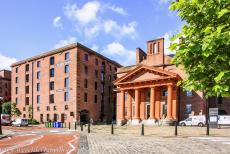
Liverpool - Maritime Mercantile City: The Royal Albert Dock Traffic Office was built in 1846-1847. The Royal Albert Dock Traffic Office is built of red brick. Remarkable features are the cast iron Tuscan portico and the frieze. The building was restored with the rest of Royal Albert Dock in the 1980s. Nowadays it houses the International Slavery Museum, which is dedicated to the history of the transatlantic slave trade. The Albert Dock Traffic Office is nowadays also known as the Dr. Martin Luther King Jr. Building.

Liverpool - Maritime Mercantile City: The Royal Albert Dock was opened in 1846. It was regarded as a revolutionary docking system because the ships were loaded and unloaded directly from and to the warehouses. Today, the Royal Albert Dock houses shops, many visitor attractions, a visitor centre and Tate Liverpool. Tate Liverpool opened in 1988 to house a collection of modern art.
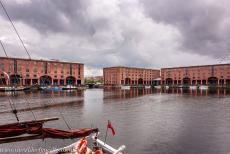
Liverpool, a Maritime City: The Royal Albert Dock Warehouses were opened between 1846 and 1847; the iconic warehouses were entirely fireproof. The Royal Albert Dock was named after Prince Albert, husband of Queen Victoria. The former UNESCO World Heritage Site 'Liverpool - Maritime Mercantile City' comprised six areas associated with the commercial Port of Liverpool at the time of the greatest global influence of Britain.
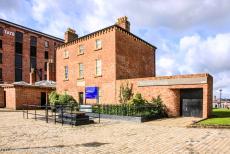
Liverpool - Maritime Mercantile City: The 19th-century Piermaster's House is situated in the Royal Albert Dock. Liverpool - Maritime Mercantile City was declared a UNESCO World Heritage Site in 2004. The former site included six areas featuring commercial, civic and public buildings, including St. George's Plateau, the Pier Head, and several docks, such as the Wapping Dock, the Salthouse Dock, the Canning Half Tide Dock, the Stanley Dock and the Royal Albert Dock.
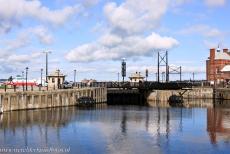
Maritime Liverpool: The Canning Half Tide Dock. The Port of Liverpool played a major role in the development of dock construction, port management and international trading systems in the 18th and 19th centuries. Liverpool also played a leading role in the transatlantic slave trade and was the major port for the mass movement of people; the emigration from Europe to the New World, particularly America.
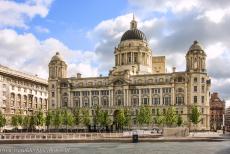
Liverpool - Maritime Mercantile City: The Port of Liverpool Building is situated at Pier Head. The domed Head Office of the Mersey Docks and Harbour Board was completed in 1907. The Port of Liverpool Building has cast iron gates and gate piers decorated with maritime symbols, such as mermaids, shells and anchors, and lamp holders with naval monuments.
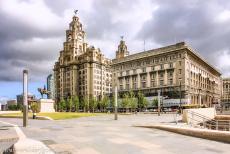
Liverpool - Maritime Mercantile City: The Royal Liver Building (on the left) was built in 1908-1911. At the time one of the tallest buildings in Europe; it is known as one of Britain's first multi-storey reinforced concrete framed buildings. Each clock tower is topped by a green copper Liver Bird, a symbol of Liverpool. The Cunard Building (on the right) was built in 1914-1917 for the Cunard Shipping Company; the building is adorned with sculptures of different ship races from around the world. The Cunard Shipping Company is one of the oldest shipping companies.

Liverpool - Maritime Mercantile City: The Beatles Story is a museum and exhibits an impressive collection of memorabilia of the Beatles, including original musical instruments of this famous rock band, such as the New York piano of John Lennon and a drum kit used by Ringo Starr. The museum is situated on the waterfront of the Royal Albert Dock in Liverpool, the birthplace of the Beatles.

Liverpool - Maritime Mercantile City: The India Building is an immense office block; it was built for the Blue Funnel Line from 1924 to 1931. The design of the building was influenced by the Italian Renaissance style. The India Building has stripped classical façades. During World War II, the building was badly damaged by aerial bombing but was later restored to its former beauty.

Liverpool - Maritime Mercantile City: The County Sessions House, the former courthouse, was built between 1882 and 1884. The building is located on St. George's Plateau next to the Walker Art Gallery. The former courthouse is now used for the staff offices and collections storage of the Walker Art Gallery. The building is not open to the public.
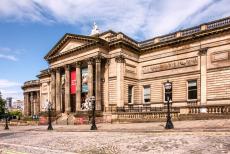
Liverpool - Maritime Mercantile City: The Walker Art Gallery was founded in 1877. It was named after its principal benefactor Andrew Barclay Walker, the Mayor of Liverpool at that time. The classical portico is the centerpiece of the exterior. The gallery stands near St. George's Plateau. It houses paintings, sculptures and decorative art from the 13th century to the present day. The art collection includes paintings by Rembrandt, Rubens and Turner, but also paintings by Monet, Degas, and Hockney.
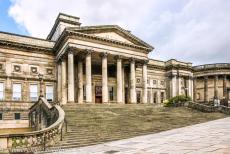
Maritime Liverpool: The Neoclassical building housing the World Museum Liverpool and the Liverpool Central Library was built near St. George's Plateau from 1857 to 1860. The museum exhibits amazing objects, including casts of dinosaur bones and Egyptian mummies. St. George's Plateau is lined with Neoclassical buildings; one of them is St. George's Hall, widely regarded as the world's greatest Neoclassical building.

Liverpool, a Maritime City: St. George's Hall was built between 1840 and 1855. Externally, St. George's Hall is built in Grecian style, with a Roman interior. The Great Hall has a Minton tiled floor and Willis Great Organ. The Small Concert Room was often visited by Charles Dickens, a well-known English novelist of the Victorian era. Dickens gave several readings in the Concert Room. St. George's Hall is situated on St. George's Plateau.
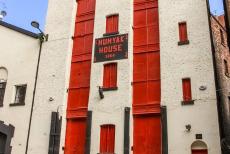
Liverpool - Maritime Mercantile City: The Humyak House in Duke Street; the 4-storey warehouse was built in 1864. The Humyak House still retains its complete hoist and cast-iron shutters; it is a typical example of the warehouses of the Victorian era. The building is a excellent example of a Victorian fireproof warehouse. The merchant's houses and warehouses around Duke Street are an important part of Liverpool's history as a trading city.

Liverpool - Maritime Mercantile City: The impressive Dock Wall and the main entrance gate into Clarence Dock. The wall was built of red brick with sandstone copings. The purpose of the wall was to control, rather than prevent, access from the town into the docks. In the 19th century, the monumental gateways with wooden gates made the docks into a fortress-like stronghold. Liverpool - Maritime Mercantile City lost its UNESCO World Heritage status in July 2021, due to modern developments on its waterfront.
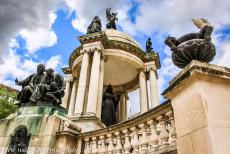
Liverpool - Maritime Mercantile City: The Queen Victoria Monument is situated on Derby Square, on the location of the former Liverpool Castle. The Neo-Baroque monument was sculpted by the British artist Charles John Allen and it is his most ambitious work. The monument was unveiled in 1906; it features 26 figures, the central figure portrays Queen Victoria in her later years.

Liverpool - Maritime Mercantile City: The chimney of the Pump House is reflected in the water of the Royal Albert Dock, the heart of the Port of Liverpool. Today, the Royal Albert Dock is one of the most famous tourist attractions in Liverpool and among the most visited tourist attractions in the UK. Liverpool - Maritime Mercantile City was declared a UNESCO World Heritage Site in 2004. In 2021, it was removed from the World Heritage List because new building projects were regarded as a threat to the historical heritage.
